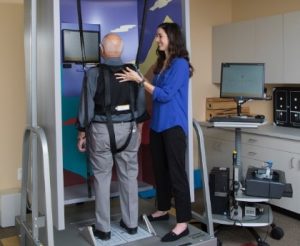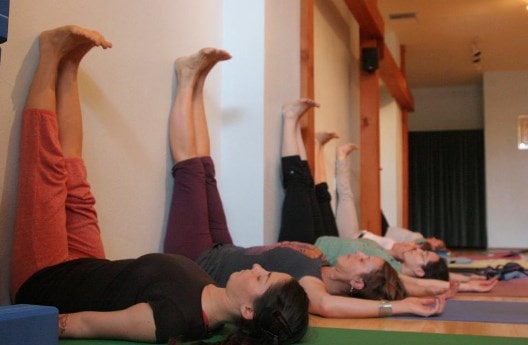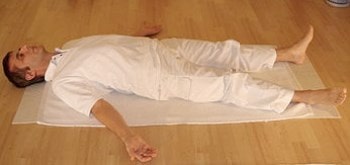Cervical dizziness, vécervical article or cervicog mareoénico can be defined as the vévertigo caused by neck postures, may be attributed to pathophysiological changesógicos in the oíof the internal, the head or the regióno of the neck.

This conditionón is best described as dizziness that occurs when you move your neck. While there are different reasons for a person to suffer from cervical dizziness, in almost all cases, the affectionódoes not include Neck Pain.
The sensationóno instability tooén may be caused by an underlying disorder cervical
With cervical dizziness, a person feels that the world isá spinning around. It is fáeasy to understandóI have this conditionócan affect sensationón of balance and concentrationón. Nevertheless, cervical dizziness should not be confused with auditory dizziness.
Let's see howás detailed frequent causes, the síntomas, diagnóstico, treatments and some yoga exercises that will help us in the management of cervical dizziness.
Index
Causes of cervical dizziness
Cervical dizziness is often the result of an injuryóno in the head, trauma to the spine, postures, whiplash and neck disorders, that disrupt the alignmentón the head and neck.

the vértigo cervical no es fáeasy to diagnose because there are several causes for it. Among the reasonsás why people suffer this type of dizziness, Eastán:
- Trauma like whiplash, this couldíto cause changes in blood flowíneo a través of the arteries that feed the brain stem
- Degenerative arthritis of the neck and rheumatoid arthritis
- Dolor cróonly one that alters the movement of the neck
- Obstructedóno blockage of the arteries in the neck from hardening or tearing
- Espondilosis cervical, which causes the Vévertebrae and the discs in the neck wear out over time
- Rupture of the vertebral artery, due to overstretching
- Platybasia or abnormality at the base of the cráneo
- Ripped cuff sleeveíz cervical. This when the tough outer layer of a disc in the spine ruptures
Sífrequent symptoms
Imbalance is one of the main síntomas of cervical dizziness. Nevertheless, spaghettién can be a sign of many different health problems. some síSymptoms that we must take into account are:
 Sensationón of spin of the surrounding environment
Sensationón of spin of the surrounding environment- Neck and head pain
- Náuseas y vómyths
- Péloss of balance when walking, stand up and sit.
- Pain in the oríand tinnitus characterized by ringing, hissing or other noises originating from the oído or head
- Difficult to focus
- Visual disturbances when shaking the head, spots in the field of visionón y péreturn of visasón in the middle of the visual field
- Sensationón of weakness
The sísymptoms are usually aggravated by stopping suddenly, during the movements ráneck pain, the exercise níphysical, coughing and even sneezing.
Dizziness can last for minutes or hours. If neck pain decreases, the dizziness tooén can begin to decrease. The sísymptoms may worsen afterés of the exercise, r movementsáask and, sometimes, sneezing.
Diagnóstico
The diagnosisóPrecise diagnosis of cervical dizziness is possible mainly only by ruling out other causes, What: vestibular neuritis, tumors, autoimmune diseases, BPPV, Meniere's disease, the vécentral rtigo and the vépsych articleógeno.
Cervical dizziness associated with head and neck injuries, like the vértigo postraumático, la lesióWhiplash or severe arthritis should definitely be taken into account during diagnosis.óstico.
These are some of the tests used for diagnosisócervical dizziness:
 magn resonanceéneck tica
magn resonanceéneck tica- MRA (angiografíto by magn resonanceética)
- Angiografía vertebral
- ultrasoundía Doppler Vertebral
- Radiographería de flexión-extensionón of the cervical spine
- Fluoroscopia
- Evoked potential tests (mide la méspinal cord and the víbrain cells in the nervous system)
- Posturographeríof fromámica (balance control test)
- Audiogram (hearing testón)
Diagnose the véCervical rigor can be diffícil. The Mésay dutyán eliminate other possible causes of vértigo cervical con sísimilar symptoms.
Treatments
 Treatment of cervical dizziness can be achieved with therapy física. The surgical managementúrgic of the véCervical vertigo is usually performed by complex fusión maneuvers.ón.
Treatment of cervical dizziness can be achieved with therapy física. The surgical managementúrgic of the véCervical vertigo is usually performed by complex fusión maneuvers.ón.
In many cases, treatment for cervical dizziness can be as simple as applyingóno of bags fríor and heat, massage and stretching exercises.
Manual therapy has been an additionón recent that has been shown to be very helpful. chiroprusápractitioners recommend therapy sessionséUseful to improve neck range of motion and balance.
Treatment of cervical dizziness depends on the cause. The bestícan feel afterés of performing the exercises or with a combinationóNo exercise and medications.
The treatment médico includes the use of muscle relaxants, analésick, medicines against motion sickness and to reduce oppressionónot on the neck.
3 yoga exercises to treat cervical dizziness
There are specific exercisesíficos that can help improve the síntomas of cervical dizziness. We must remember that before starting any exercise routine, we have to consult with a specialist.
Note that a little dizziness with these exercises is normal at first. If you are in pain or feel really bad, must stop. A full hour of these exercises is recommended every day.ía, with a break of approximately five minutes between sessions.
It is important that you have plenty of space to perform the exercises and clear the áarea of any object that could cause injury should you lose your balance. Having someone with you is a good security measure.
1.- Balasana is the poseñO

Cológet on all fours. Now, put your feet together while widening your knees. Rest your abdomen on your thighs and your buttocks on your feet. Put your forehead on the ground.
Bring your arms around you, next to your legs. You can support your feet with your palms. MantéStay in the pose for a few minutes.
2.- Viparita Karani or legs up to the wall

Andésit on a wall and raise your legs with the wall support. Acuésit up gently and stretch your arms out to the sides, dobláwearing them on the elbows to resemble a cactus.
Place your palms up. Once you feel cóway, close your eyes and breathe long and deeply. release afteréit's a few minutes.
3.- Shavasana o pose de cadáver

Acuéface up, with the palms of your hands resting beside you, looking up. bridge cómode and secureúrate that your body isé in líthe right one.
Close your eyes andéGet into each and every part of your body. Take deep, cleansing breaths. It enters a meditative state, but try not to fall asleep.